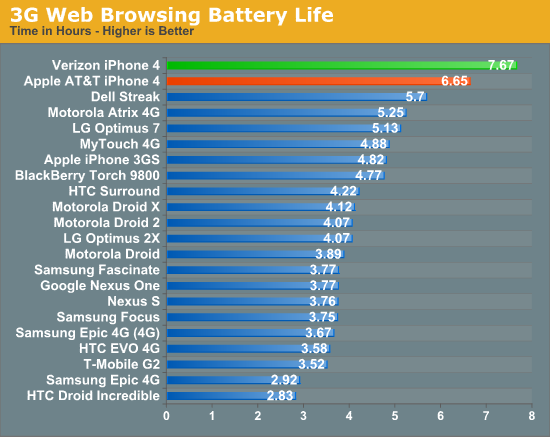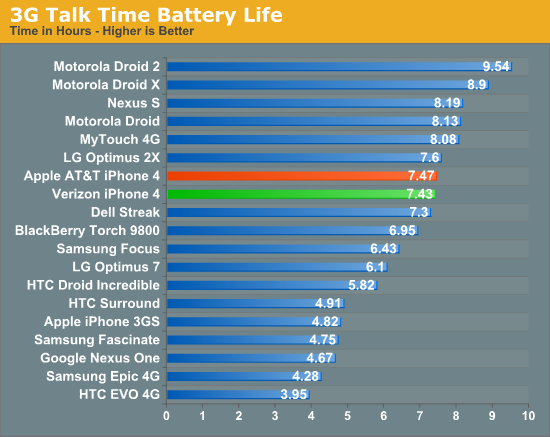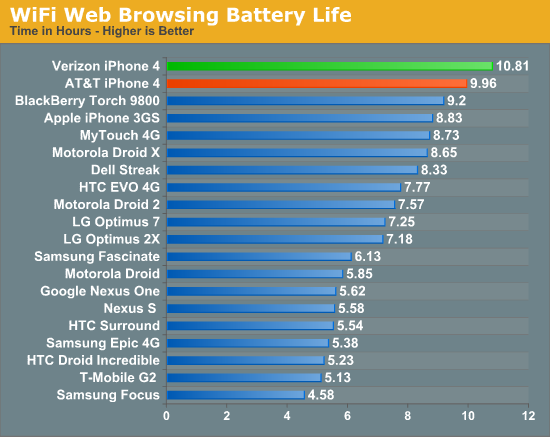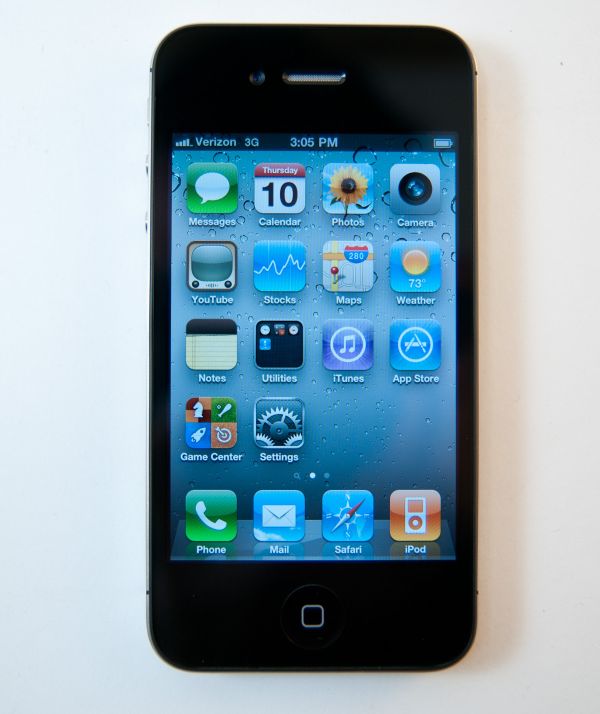Verizon iPhone 4: Thoroughly Reviewed
by Brian Klug on February 13, 2011 9:32 AM ESTBattery Life
With a new baseband comes new battery life. We ran our usual suite of battery life tests on the Verizon iPhone 4. I was running the last test - WiFi battery life test - when it was time to hop on the plane for MWC. That test hopefully won't change too much, as it's the same WiFi/Bluetooth stack as the previous iPhone 4. As soon as we're back, it'll get tested and the graph will appear. One of the other things we've been working on is a WiFi hotspot battery life test. I've been gathering numbers from every phone so far with official support for WiFi tethering, the iPhone 4 on Verizon will be put to the test the same way.
Update: We've added the WiFi web browsing battery life numbers down below, and they're class leading. WiFi tethering numbers are coming soon.



Call time is shockingly close between the two iPhone 4s. The Verizon iPhone 4 also soundly beats the AT&T iPhone 4 in the 3G web browsing and WiFi battery life department, shooting it to the top of our chart. Qualcomm's MDM6600 appears to be comparable if not better than the Infineon in the power department, though it's hard to be sure without having HSPA working for a direct comparison.
Final Thoughts
So the long-awaited Verizon iPhone 4 is finally here. It's functionally the same as the GSM/UMTS iPhone 4 on AT&T, except significantly less prone to unintended signal attenuation from being held thanks to receive diversity through two cellular antennas. Battery life is the same or better than the AT&T iPhone 4, GPS is slightly more precise, Verizon lets you turn your phone into a WiFi hotspot if you pay the fare, and SMS concatenation even works on Verizon's network. There's really nothing to complain about at all or point out as being inordinate about the CDMA iPhone - it's simply an iPhone 4 on Verizon's network.
At the same time, so many more questions linger. Where is the elusive White iPhone 4? What will iPhone 5 bring when it arrives presumably during the normal summer refresh cadence? Is the MDM6600 the baseband Apple will go with for the next device as well, perhaps this next time including the power amps necessary for dual-mode operation? It's impossible to say for sure what will happen, and we rarely dabble in such murky, speculative waters.
I have no doubt that tomes have been written about the differences between AT&T and Verizon already. It's a debate that has raged on like some sort of cellular analog of the 100-year-war, with each camp ideologically entrenched and beyond the point of reason. Ultimately, picking which is better is a matter of making tradeoffs. There's no simple way to answer which is the "better" carrier, as the figures of merit change from person to person. If voice calls are what's absolutely most important to you, get the Verizon iPhone. If much faster 3G data is what's most important to you, get the AT&T iPhone. If having more ubiquitous data coverage (at the expense of speed) sounds reasonable, get the Verizon iPhone. If the simultaneous voice/text and data issue is something you feel strongly about, get the AT&T version. Above all else, find out who has better coverage in the areas that actually matter to you - the workplace, at home, and along daily commute. Until carriers report coverage with actual numbers and following some standard, take coverage maps with a hearty dose of skepticism. The only way to know for certain is to either borrow a friend or his phone, or make liberal use of return policies.
Ultimately, the larger net effect of the Verizon iPhone 4 will be to increase pressure on Android. Verizon is the carrier that Google's platform has arguably enjoyed the most success with. Having an iPhone doing direct battle on the same carrier isn't so much optional for Apple anymore as it is necessity. Even if you disagree with the philosophical choices that iOS has made, you have to hand it to Apple for catalyzing changes that will force carrier competition based on the merits of their networks.












35 Comments
View All Comments
walmartshopper - Monday, February 14, 2011 - link
"With the phone facing up, the first cellular antenna consists of the new strip at the very top. The second is the strip running from the bottom left, across the bottom, and up the right side of the phone. The far left side with volume buttons and the vibrate switch is part of the WiFi and Bluetooth antenna."In the picture below that, the phone is face down, so shouldn't the colored labels be reversed?
ol1bit - Monday, February 14, 2011 - link
I know in the city it "might" not make a difference, but here in Phoenix, AZ (no hills, etc). My AT&T work phone drops out just driving from Goodyear to downtown on the morning commute (I-10). My Verizon droid does not.Next up: offroading
Doesn't matter where I have been, my AT&T phone lost signal pretty much as soon as I hit the dirt. My friends Verizon phones worked 90% of the time.
So I waited and waited for a powerful Smart phone on Verizon and I got my Droid. No more no-signal! I was on a power line dirt road 30 mile from Prescott with terrain mapping on and seeing the little more that cow trails on one of my 3 day quad trips, it was a big help!! My work AT&T phone dead for the entire 3 days!
So the difference may not be much in the city, but where Verizon really shines is outside of the city. It was simply amazing that I had data so far out and not even voice with my At&T phone.
7Enigma - Tuesday, February 15, 2011 - link
I kept finding myself trying to figure out which phone in your review was the Verizon and which the AT&T. For those of us not up on the lingo of UMTS and CDMA it is a bit confusing. I would have preferred if you had just changed these to say Verizon and AT&T so I could read it more fluidly without constantly having to sit and think which carrier you are talking about.Great review though!
Thanks
chupacabramike - Thursday, February 17, 2011 - link
Guh I can't believe people are still defending at&t service. Look at any customer satisfaction stat..any of them and you will see Verizon soars while at&t sinks. Being able to actually use your phone as a phone priceless. Thank you Apple and Verizon for finally giving us a choice.pshen7 - Thursday, February 17, 2011 - link
Can't wait for the Verizon iPhone! I'm tired of the dropped calls from ATT. My contract is up too so switching should be easy. I'm sure millions feel the same way like I do.Peter, founder of http://koowie.com : Search.Post.Connect.
Laughing Coyote - Thursday, February 17, 2011 - link
FYI, the AT&T iPhone 4 doesn't come with a SIM ejector tool either. Though it apparently does in some other countries.http://www.apple.com/iphone/specs.html
skyflyrr - Thursday, February 17, 2011 - link
Working in the RF wireless field I must commend you on the first accurate tear down and labeling of components of the Verizon iPhone 4.Reviews of Reviews - Friday, February 18, 2011 - link
For a not-quite-so-thorough review of this review, check out www.reviewsofreviews.comfadam - Sunday, February 20, 2011 - link
On the second page, it seems that the paragraph describing the location of the antennas does not match the photo. The text references the iPhone being "face up" while the photo shows the phone face down. The highlighting of the antennas would need to be mirrored in the picture in order to match the text. Really enjoyed the writeup.asandok2 - Monday, February 21, 2011 - link
Thanks for the reply! I thought that would be the case! I found a thread on macforums from last year where a guy speculates that the backplate has something to do with the antenna system too.http://forums.macrumors.com/showthread.php?t=95718...
Any idea if there is truth to his theory?? Is that part of the cellular antenna too?? Thanks in advance!